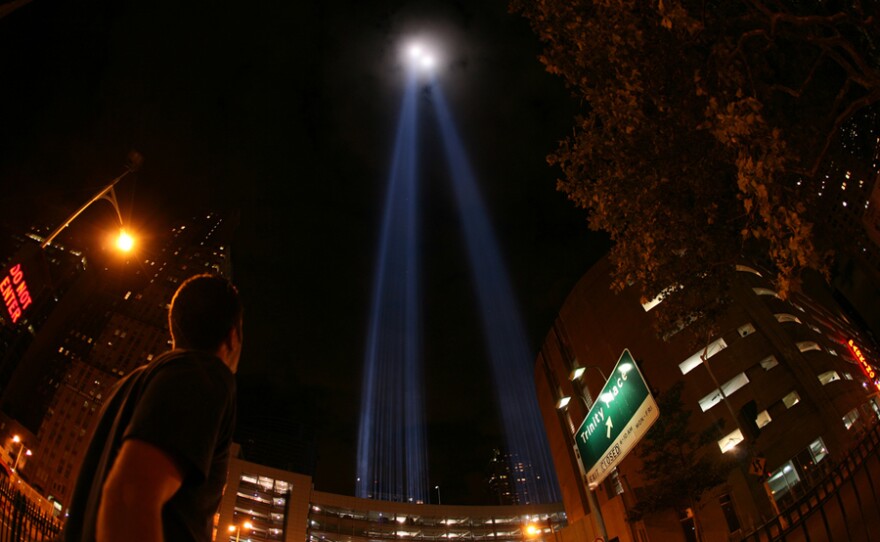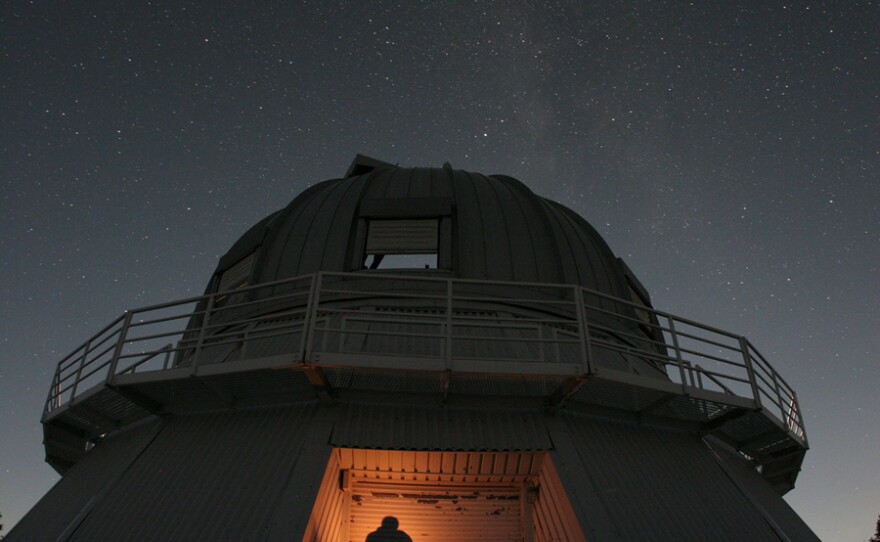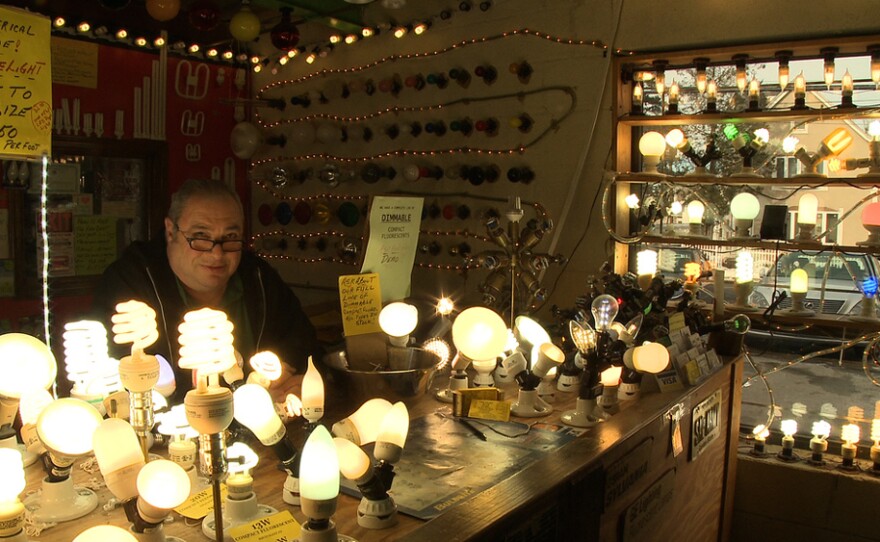The town in rural Maine where Ian Cheney spent much of his childhood has about 4,000 residents. Waldoboro had electric lights, but on a cloudless and moonless night, it was impossible not to be struck by the incredible array of stars visible above. Cheney became deeply curious about the stars, as humans have been for millennia. He followed his passion into amateur astronomy, fashioning his own homemade telescope, and then into astrophotography to capture the wondrous scenes that revealed themselves at night.







View Maps of the Earth at Night
This interactive map created by PBS Newshour uses imagery from the NOAA's National Geophysical Data Center, which maps light pollution across the world. Find out how your hometown fares by zooming in and looking around!
Filmmaker's Quote
“Spending a lot of my childhood in rural Maine, I fell in love with the night sky and wanted to try and capture it as best I could,” says director Cheney. “I used a Pentax camera borrowed from my dad, a high school photography teacher, and used an unforgivable amount of his Kodak Gold film. But when I moved to brightly lit cities, my connection to stars faded and I began to feel I was losing something important. I asked myself, ‘Why do we need the stars?’”
Cheney continues, “'The City Dark' took three years to make. I began by speaking with astronomers, which pushed me toward two other lines of inquiry: the intangible idea of our spiritual and emotional connection to the stars and the science of the night, including the effect on humans and wildlife. The film carries these themes forward by weaving together more poetic, meditative footage of the night sky with handheld footage of people exploring these issues by day. My hope is that the film will inspire people to look up more; to reconsider the way their houses, streets and cities are lit; and to realize that tiny changes in the way we light our world can make a big difference.”
But when Cheney moved to New York City, his familiar world of light and dark was upended. In this metropolis, light was everywhere—but starlight was much harder to find. New York’s brilliance was undeniably alluring, yet for Cheney the glare of streetlights also suggested a deep loss. "The City Dark" follows Cheney’s journey to discover the surprising and alarming costs of light pollution and the disappearance of the night sky.
The world’s first light bulb was switched on in 1879, and since then artificial illumination has spread across an increasingly urban globe, radically changing humanity’s relation to the night. Yet light pollution is a phenomenon little noted except by those, like astronomers, whose endeavors have been directly hindered by the changes.
Meditating on his dwindling connection to the stars, Cheney wonders about the global consequences of artificial lighting, and in "The City Dark" he sets out to discover what ecologists, cancer researchers, astrophysicists, philosophers and designers have to say about it. Cheney weaves these interviews with time-lapse images of the night sky, culled from tens of thousands of high-resolution still images shot around the world.
The filmmaker discovers an informative and intriguing cast of characters. Irve Robbins, a Brooklyn-born astronomer running the last remaining observatory in Staten Island, N.Y., is a surprising reminder that stars could once be studied in New York City. Now only the brightest objects shine through the light-polluted sky. Robbins says, “I’ve seen the Milky Way twice—when there were blackouts.”
At a vast Hackensack, N.J., warehouse filled with myriad light bulbs, owner Larry Birnbaum shows off antique bulbs, including an original Edison that still works, and explains that successive generations of bulbs have exponentially increased in brightness. Today’s bulbs produce thousands more lumens than earlier ones—often many more lumens than we need.
The effect has not been lost on Manhattan Boy Scout Troop 718, whose leader jokes that wayfinding in a dark forest now means following the pinkish glow in the night sky. These Scouts must embark on a trip far from the city to see the Milky Way for the first time.
Another native New Yorker, astrophysicist Neil deGrasse Tyson, describes falling in love with the stars during his first visit to the Hayden Planetarium in Manhattan—noting the irony of being smitten with an artificial night sky while the real sky above his own Bronx neighborhood revealed just a handful of stars.
Cheney leaves New York City seeking darker skies and finds his way to Sky Village, a dark-sky haven for astronomers in rural Arizona. While the village’s denizens come from all walks of life, what draws them together is their need to be close to a dark night sky. Cheney visits a mountaintop in Mauna Kea, Hawaii, considered the best site for professional astronomy in the world.
Astronomers rely on Pan-STARRS, the world’s newest, largest telescope-camera to detect Earth-killing asteroids, but even here, urban growth in the valley below creates a luminous haze that impedes their work. “It’s as though you’re looking through fog,” says John Tonry of the University of Hawaii.
But astronomers are far from the only ones affected by the worldwide retreat of the night. Biologists along the Florida coast have determined that thousands of hatching sea turtles die every year because they fail to make it to the ocean after they confuse the light-polluted horizon of the land with the starlit horizon of the sea and head the wrong way.
Similarly, millions of birds, evolved to navigate by the stars, crash into brightly-lit city buildings each year during migration season. This raises the question: Do humans also need the dark?
Suzanne Goldklang for years worked a night shift selling jewelry on television. Now a breast cancer patient, she is surprised to learn about epidemiologist Richard Stevens’ suggestion of a link between persistent exposure to light at night and increased breast cancer risk. Indeed, Stevens’ research shows that female night-shift workers are almost twice as likely as day-shift workers to develop breast cancer.
The disruption of humanity’s millennial cycle of light and dark may have profound physiological consequences; the World Health Organization has even deemed shift work a probable carcinogen.
Artificial light has undoubtedly revolutionized life in numerous positive ways—beating back humanity’s fears of the dark, extending the active day and facilitating productivity and social interaction. Historian Roger Ekirch notes that every civilization has expressed a fear of the dark.
Criminologist and former policeman Jon Shane says, “History is replete with examples of poorly lit areas that are transformed by light,” and goes on a nighttime visit to a Newark, N.J., park once riddled with crime. Neighbors attest that the installation of more lighting has made the park markedly safer. But the extent to which increased lighting reduces crime remains controversial; and though Cheney acknowledges that humans are drawn to the light, he also asks if there’s such a thing as too much light.
Notes astrophysicist Tyson, “When you look at the night sky, you realize how small we are within the cosmos. It’s kind of a resetting of your ego. To deny yourself of that state of mind, either willingly or unwittingly, is to not live to the full extent of what it is to be human.”
"The City Dark" is a production of Wicked Delicate Films, presented by POV. "The City Dark" is on Facebook, and you can follow the filmmaker @iancheney on Twitter. POV is on Facebook, and you can follow @povdocs on Twitter.
The City Dark: Filmmaker Interview with Ian Cheney
"On a search to discover what he lost when he moved to New York City from rural Maine and found a night sky devoid of stars






